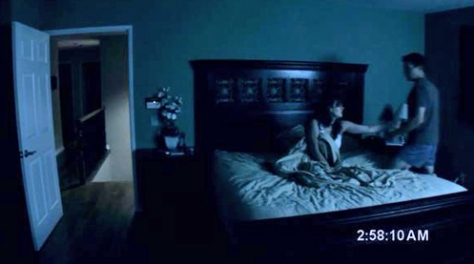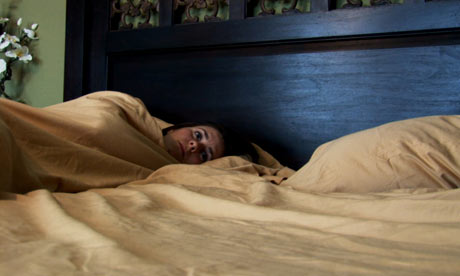Like any city, Cinephile City runs on debate. City Council is our regular feature in which we discuss an issue that one of our writers notices in the world of cinema. Today is the Opening Argument, tomorrow is the Debate. This week’s issue is Resolved: Paranormal Activity is the most important movie in the era of modern horror.
Horror trends tend to be cyclical. First comes a game changer, a film original and novel enough to stand out from previous trends that have stagnated. Then come the inevitable imitators: some good, some uninspired cash grabs. There is a brief heyday of films that balance originality and bandwagon-jumping. Then, just as the genre begins to stagnate again, another very different and very successful horror film comes along and triggers the cycle again. While the found footage horror film seems like a cheap and predictable cliché in the present day, at the time of Paranormal Activity‘s release it was a format that both challenged the norm and changed the landscape of genre film for the next several years.
Paranormal Activity was not the first found footage film to make such an impact on the horror scene; The Blair Witch Project ten years before was a runaway phenomenon made under similar circumstances. Unlike the horror landscape after Blair Witch, however, found footage narratives flourished in the wake of Paranormal Activity‘s success. The mere circumstances of the film’s wide release sets it apart from its contemporaries. Made by first time director Oren Peli for a mere $15,000, Paranormal Activity remained a sort of mystery film for a few years, playing a handful of film festivals but generally unseen by the public. Eventually Paramount Pictures snapped it up, then let it sit on the shelf for a maddening amount of time; at one point, they planned to remake the film with name actors and a much higher budget. This of course would have undermined a large part of what makes Paranormal Activity so effective, which is the sensation of realism created by the cast of unknowns and the raw, amateur aesthetic of the footage.
The film’s simplicity, both in narrative and effects, was a breath of fresh air at a time where the genre was still glutted with Asian horror knockoffs and variations on torture porn. Here was a story unconcerned with convoluted mythologies or grotesque shocks. The narrative immediately places the audience in the midst of the plot; the haunting is already underway in Katie and Micah’s home, and Micah has bought the camera with the express intent of documenting the strange occurrences which are already happening. This conceit allows the movie to cut to the chase, plunging the viewer straightaway into the action without dwelling on character development or extraneous setup. While some symptoms of the haunting occur in broad daylight, the majority of the happenings take place in front of the stationary camera in their bedroom in the middle of the night, Katie and Micah asleep and unknowing. It taps into the primal fear of being watched while unconscious and helpless,and the film stretches this anxiety to nearly unbearable levels.
 The sense of foreboding that permeates Paranormal Activity is twofold. First, the viewer and the viewer alone witnesses the nightly hauntings: doors opening and closing by themselves, phantom footsteps tramping ominously up the stairs. Then, as Katie and Micah watch the previous night’s footage, their reactions of fear and disbelief both mirror the audience’s fear and accentuate it. Their feelings of helplessness in the face of terror are akin to the experience of watching the film itself – constantly on edge and expecting the worst.
The sense of foreboding that permeates Paranormal Activity is twofold. First, the viewer and the viewer alone witnesses the nightly hauntings: doors opening and closing by themselves, phantom footsteps tramping ominously up the stairs. Then, as Katie and Micah watch the previous night’s footage, their reactions of fear and disbelief both mirror the audience’s fear and accentuate it. Their feelings of helplessness in the face of terror are akin to the experience of watching the film itself – constantly on edge and expecting the worst.
The majority of the effects are either sound-driven or small visual touches – wind blowing through indoor plants, the door creaking open and shut. The most impressive visual in the first half is the scene of an unaccompanied Ouija board catching on fire. Post-production effects were kept to a bare minimum by Peli (the jump-scare ending was created by Paramount), and much of what makes the movie so effective is the clever use of sound and the static position of the camera. The viewer is constrained by what the camera sees, which ramps the suspense up to a fever pitch when bumps in the night happen just outside of the frame. What the viewer cannot see is often more terrifying that what the viewer can see, and the film capitalizes on this to the hilt. The demon that has latched itself onto Katie is never shown onscreen, save for a brief shadow or footprints appearing in powder. Nonetheless, the entity is frighteningly effective, especially when the viewer is waiting in dread for the next time it will appear.
 Much of what also makes the film work is the capitalization of communal experience. When Paranormal Activity was finally released, the bulk of the marketing did not focus on the plot. Instead, the focus was placed on how terrifying the viewing experience was for audiences. Trailers and tv spots focused primarily on viewer reactions, punctuated by mere glimpses of the film itself. In a pre-VOD age, when Netflix Instant wasn’t the household mainstay it is now, this focus on the importance of seeing the film with a theater full of like minded people is now rare, if not nonexistent.
Much of what also makes the film work is the capitalization of communal experience. When Paranormal Activity was finally released, the bulk of the marketing did not focus on the plot. Instead, the focus was placed on how terrifying the viewing experience was for audiences. Trailers and tv spots focused primarily on viewer reactions, punctuated by mere glimpses of the film itself. In a pre-VOD age, when Netflix Instant wasn’t the household mainstay it is now, this focus on the importance of seeing the film with a theater full of like minded people is now rare, if not nonexistent.
The success of Paranormal Activity proves that small outsider horror films can still find an audience and flourish. A truly scary film doesn’t need flashy CGI or recognizable actors – sometimes all you need is a camera and a subtle, intense story. The success of The Blair Witch Project didn’t cause that to happen, in part because the sequel Book of Shadows: Blair Witch 2 bombed so badly that the first film could be seen as a fluke by other studios. Paranormal Activity‘s massive profit and transformation into a pop culture phenomenon changed the landscape for smaller horror films and erased all fluke possibilities forever,
While Paranormal Activity spawned a host of successors, many of which were pallid imitators, its success helped to pave the way for lower budget, riskier films to find distribution and an audience. It’s difficult to imagine movies like V/H/S and [REC] being released as widely without the precedent of Paranormal Activity‘s success. It caused studios and distributors to take more chances with the films they chose to release, allowing smaller, lower budget horror to reach a wider audience. While the found footage craze seems to be slowing down to a trickle, Paranormal Activity is a perfect case study in how, even in scary movies, simplicity is often best.
Lauren Baggett is a writer for Cinephile City.
